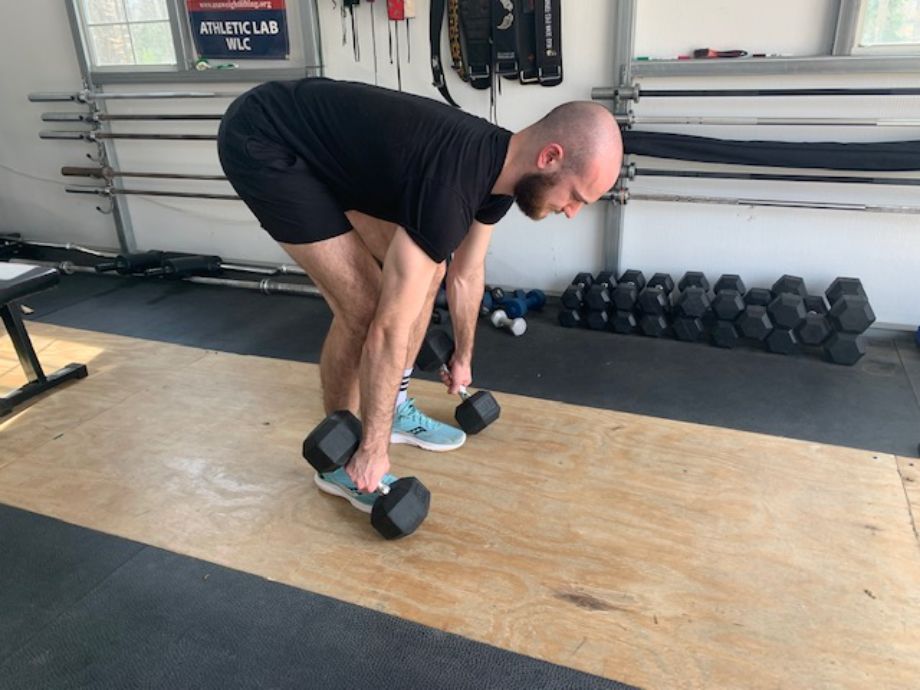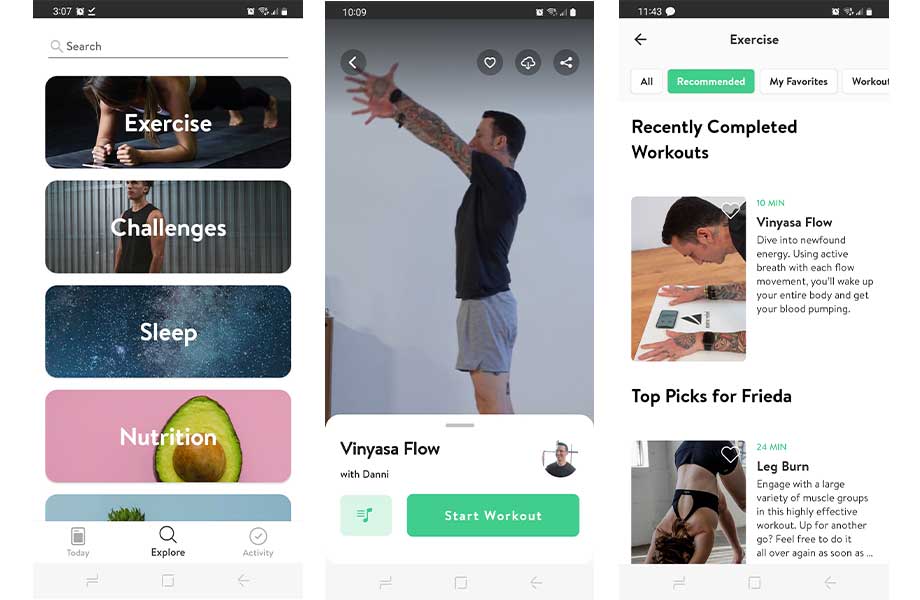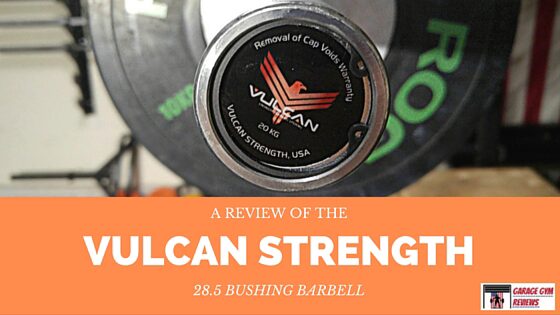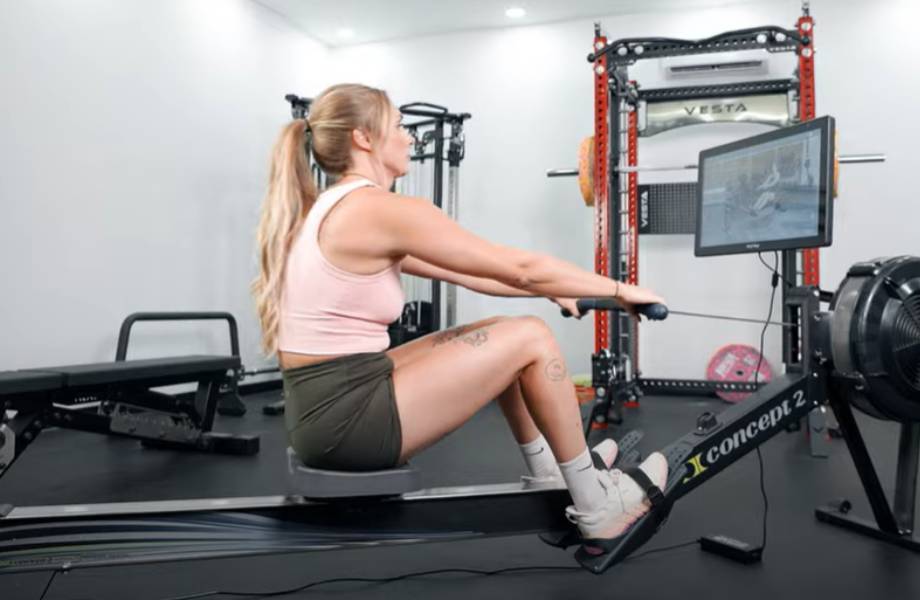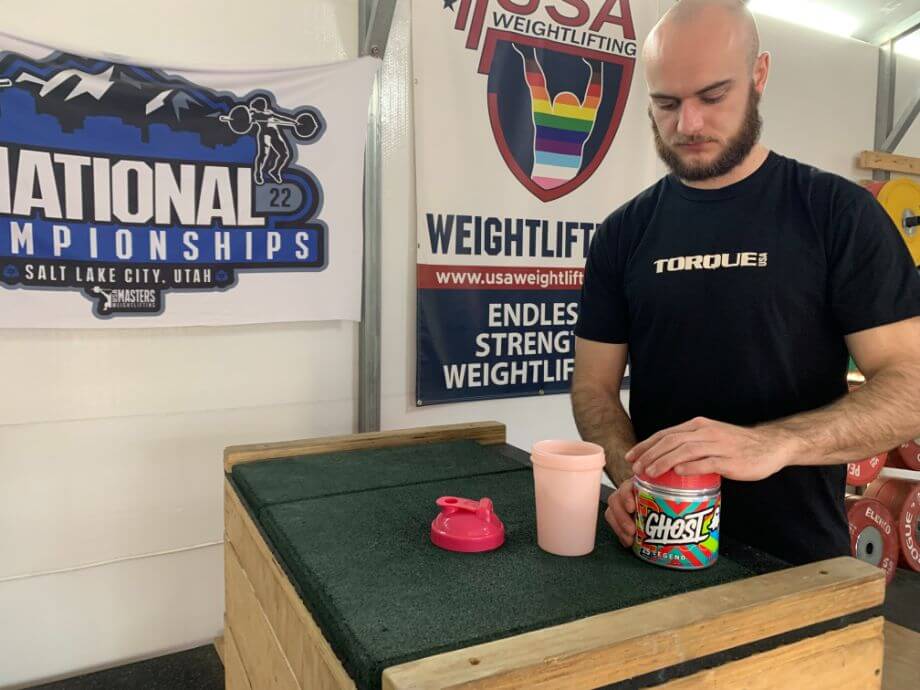There’s no doubt about it; the deadlift is one of the most fundamental lifts out there.
At a glance, the deadlift targets your posterior chain muscles like the glutes, hamstrings, and erector spinae, but it’s actually a full-body compound exercise that provides activation beyond the lower body. That’s what makes it so great for building all-around body strength, as well as encouraging hypertrophy.
The conventional deadlift calls for a barbell, but what if there’s none available? Is it possible to perform the same epic exercise using the humble dumbbell?
As a matter of fact, you can!
Learning how to deadlift with dumbbells makes for a great alternative if you’re working around a barbell hog at the gym, or simply prefer to do your strength training at home where equipment is more limited. Deadlifting with dumbbells also features a greater range of motion since you can get your upper body closer to the ground without those big ol’ weight plates in the way.
If you’re looking to find out how to deadlift with dumbbells with perfect form, we’ll cover proper deadlift form, trainer tips, common mistakes to avoid, some variations to help keep things fresh, and some handy gear that helps you kick things up a notch when the time is right.
Without further ado, the dumbbell deadlift.
How To Deadlift With Dumbbells
- Stand with your feet hip-width apart, with the dumbbells on the floor in front of you.
- Starting with a hip hinge movement, bend slightly at the knees and grab the dumbbells with an overhand grip.
- You want a tight core, flat back, and neutral spine throughout the movement pattern. Push your shoulders back and bring them down, keeping the shoulder blades pinched together. Your chest should be tall and your eyes fixed dead ahead.
- Lift the dumbbells by driving through your heels and standing up straight. Keep the weights close to your body and engage your glutes and hamstrings as you stand.
- Once you reach a standing position, pause briefly and squeeze your glutes.
- Slowly lower the dumbbells back down to the floor by reversing the movement, hinging at your hips, and bending your knees.
- Repeat as needed.
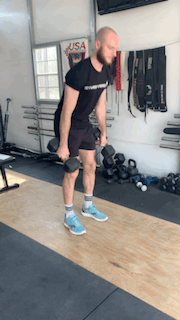
Trainer Tips for Form
When first starting out, make sure to select a lighter weight so you can prioritize proper form. To make sure you get that form picture perfect, here are tips from a certified personal trainer.
RELATED: How To Deadlift Heavier: Expert Training Tips And Tricks To Help You PR
Keep Your Back Straight
Maintaining a flat back and neutral spine is critical for reducing your risk of injury. This positioning not only allows for you to get the most effect during the actual lift, but it ensures your back muscles properly support the spine and save you from nasty injuries like sprains, strains, and disc herniations.
This is Deadlifting 101. No matter what deadlift exercise you’re performing, always keep your back straight.
Engage Your Core
One way to ensure you’re achieving good posture and keeping your back straight is by engaging the core muscles to stabilize the trunk. Doing so will provide additional support in the low back region and help reduce risk of injury, especially when you start lifting progressively heavier weights.
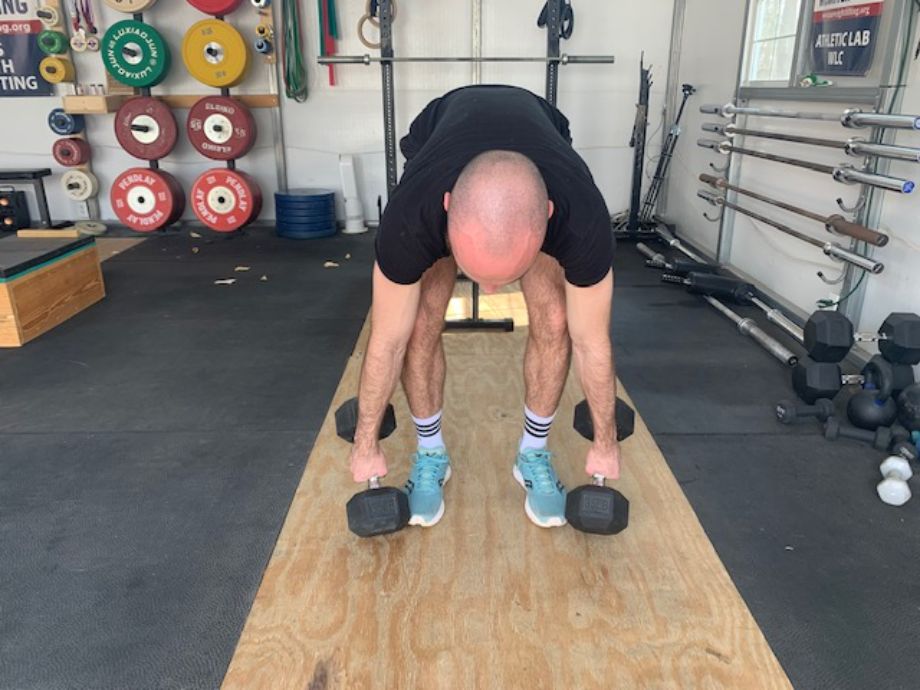
Lift With Your Legs (And Hips!)
The age-old advice applies here. Beginners might mistakenly believe you are pulling the dumbbells off the ground with your arms, but you want most of the lifting to be done from pushing from your heels, straightening your legs, and bringing your hips from their starting hinged position back to a standing position.
When done correctly, you’re mostly using your glutes, hamstrings, and hips to move the weight, not your arms.
Keep the Weights Close
Proper deadlift form demands a straight bar path, which is a little trickier to achieve when your left and right hands aren’t locked in a horizontal straight line provided by the barbell.
To compensate, try imagining that straight line that attaches your left dumbbell to your right and lift them straight up in unison, keeping the weights close to the body from the floor to the peak of the movement.
Don’t let those dumbbells drift up and away. Keep them in tight!
Take It Slow
Unless you’re doing an actual jerk lift, jerkiness is generally ill-advised. Take your time with each rep, especially when first starting out, and focus on maintaining proper form throughout the exercise.
Pause at the bottom before you start the lift and check in with your form. Then, pause from the standing position and check in with your form. Every opportunity you have to ensure your back is straight, core is tight, weights are close, and shoulders are back is an opportunity to help develop good habits and good muscle memory.
Take it slow on the way down too and control that descent. It’s often fine to drop a barbell after a super heavy deadlift, but dropping dumbbells from a standing position is dangerous. Releasing tension and letting the weights crash to the floor is also not advised, as you’re very likely to compromise your good form if you don’t control the descent and thus increase your risk of injury.
Common Dumbbell Deadlift Mistakes
Following the trainer tips above will help you develop an excellent deadlift technique. When working to get that form immaculate, steer clear of these common deadlift mistakes.
Rounding the Back
Rounding the back is one of the most common mistakes people make when deadlifting. It’s even easier to accidentally make this mistake with dumbbells since they sit lower than your typical barbell.
Make sure your back is flat and straight before beginning the lift to save yourself from lower back pain and an array of other injuries associated with poor deadlift form.
Overextending at Lockout
Overextending at lockout is another common mistake, and it refers to an excessive arching of the lower back at the end of the lift. This often happens when a lifter has already successfully completed the lift, but leans back too far at the peak of the movement to overcompensate, thus putting unnecessary stress on the lower back which could lead to injury.
Remember– flat back, tight core, shoulder blades pinned, weight in your heels. Instead of hyperextending your back at the top, focus on squeezing your glutes instead.
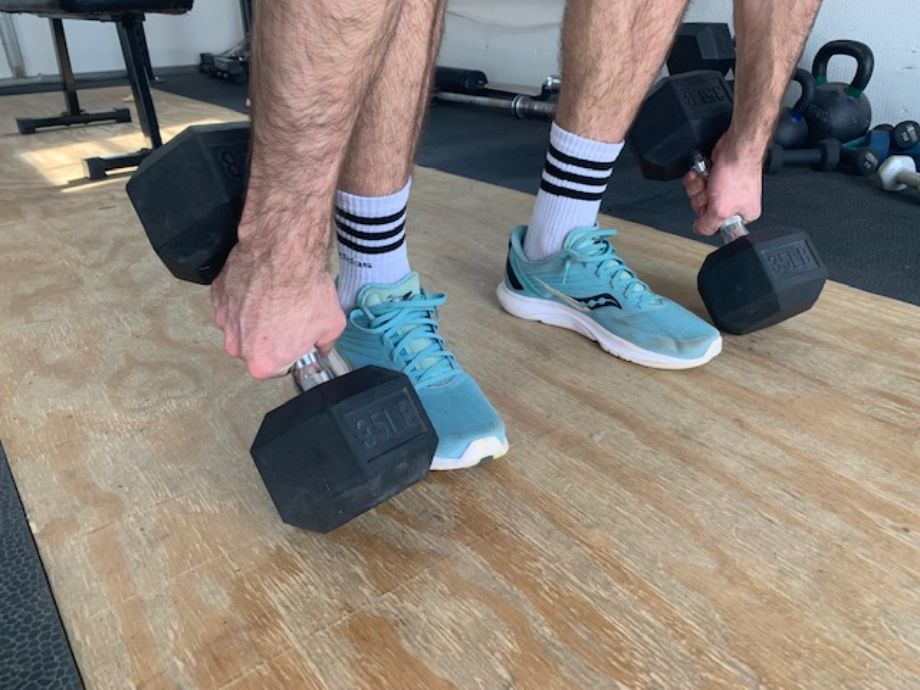
Improper Foot Positioning
Foot positioning is an often-overlooked component of the deadlift, but it’s nonetheless important. Common foot positioning mistakes include keeping your feet too close together, keeping your weight on your toes, and standing too far from the weights.
Set yourself up for success by starting with the correct foot positioning. Your feet should be hip-width apart, or even slightly wider, to provide a solid base.
Keep those toes pointed ahead, and keep your weight spread throughout the entire foot. Keeping your weight all in your heels or all in your toes could alter your bar path.
Standing too far from the dumbbells might cause you to lean forward when picking them up, which results in the forbidden rounding of the back. Start with the dumbbells close to your shins and aligned with the middle of your feet to prevent making this mistake.
Moving Too Quickly
A lot of us are pressed for time during our workouts, but rushing through the deadlift is a surefire recipe for disaster. Moving too quickly almost guarantees you compromise proper form somewhere during the set, placing unnecessary stress on your muscles and increasing your risk of injury.
Even if you’re a seasoned deadlifting pro, take your time to make sure you prioritize proper form and get the most from each rep.
Dumbbell Deadlift Variations
Once you’ve gotten your physical and metaphorical footing on the dumbbell deadlift, you might consider trying some variations to switch things up here and there.
RELATED: The 16 Best Deadlift Variations For Building Strength, Grip, And Muscle
Single-Leg Dumbbell Deadlift
Only have a single dumbbell to spare? No problem!
The single-leg dumbbell deadlift variant involves using one leg at a time to isolate a single side of the body. It’s a great variation if you’re into bodybuilding and muscular symmetry, as performing this unilateral movement helps correct imbalances.
Here’s how to do the single-leg deadlift with a dumbbell:
- Stand with your feet hip-width apart, holding a dumbbell in your right hand by your side.
- With your weight on your right foot, lift your left foot off the floor and extend it behind you.
- Keeping your back straight and your shoulders back and down, hinge forward at the hips while lowering the dumbbell towards the floor.
- Lower the dumbbell until you feel a stretch in your hamstrings.
- Slowly lift the dumbbell back to the starting position, driving through your right heel, maintaining a flat back, and engaging your glutes and hamstrings.
- Repeat as needed, then switch sides and repeat the full set.
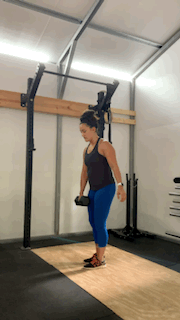
Dumbbell RDL
The RDL, or Romanian deadlift, is basically a reverse deadlift. Instead of lifting the weights from the floor, you start from the standing position, focus on lowering the weights, and return to a standing position.
The result is a core-stabilizing, hamstring-blasting, forearm-burning dumbbell exercise that provides great upside when performed in place of the conventional deadlift occasionally.
Here’s how to perform the dumbbell Romanian deadlift with great form:
- Stand with your feet hip-width apart, holding a pair of dumbbells in front of your body.
- Hinge forward at the hips and lower the dumbbells towards the floor. Your back should be flat, shoulders back and down, core engaged, and knees slightly bent.
- Continue lowering the dumbbells until you feel a stretch in your hamstrings.
- Slowly return to the starting position, driving through your heels. Avoid overextending the back once you reach the standing position.
- Repeat as needed.
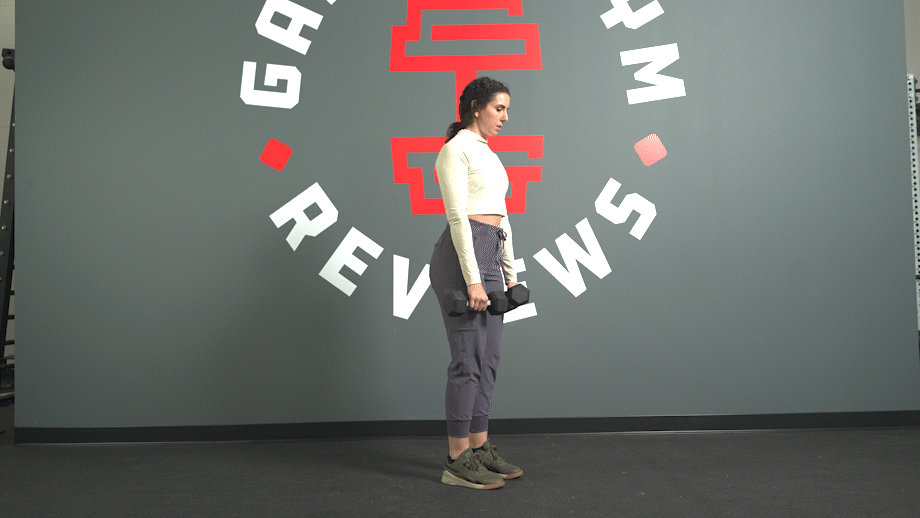
Dumbbell Straight Leg Deadlift
Also known as the stiff-legged deadlift, this variation is nearly identical to your standard dumbbell deadlift with the key distinction being, you guessed it, you keep your legs straight, or at least mostly straight.
Fully straightening your legs puts you at risk for hyperextending the knees, so it’s advised to keep a slight bend. However, this bend should be substantially less compared to the standard deadlift, putting more emphasis on your lower back, hamstrings, and glutes.
For this variation, follow the above outlined steps for the regular dumbbell deadlift, starting each rep from the floor, maintaining proper form start to finish, and incorporating a straight leg positioning that still uses a slight bend to reduce your risk of injury.
Dumbbell Sumo Deadlift
Picture a sumo wrestler getting ready to square off in the dohyo. What’s their stance look like? How far apart are their feet?
The aptly named sumo deadlift assumes a form similar to the sumo wrestler by taking the conventional deadlift and widening the stance beyond hip and shoulder width. By widening our stance, we increase our hip mobility, increase activation in the quads, glutes, hamstrings, and inner thighs, and reduce stress on the lower back and knees.
Most lifters are able to lift heavier weights from a sumo stance as well, so it’s great for strength-oriented workouts.
To perform a dumbbell sumo deadlift, simply follow the above outlined steps for the conventional dumbbell deadlift but alter your foot positioning so they are wider than hip-width and your toes point outward slightly.
Useful Dumbbell Deadlift Equipment Accessories
When starting out, we recommend using only the essentials to truly get a feel for things.
Once you’ve developed a strong foundation for the exercise, there are many equipment accessories that will help you take things to the next level.
Chalk
Chalk is a simple, inexpensive way of improving your grip strength. Using chalk helps provide better friction between your skin and the dumbbell handle. It’s especially helpful when your hands are sweaty or you’re using heavy weights that are really trying your grip strength.

Lifting Straps
They won’t let you use lifting straps during powerlifting competitions, but they are super helpful for general purpose weightlifting. Lifting straps wrap around the bar, or the handle of any dumbbell or kettlebell, to provide a secure connection and help you keep your grip as it approaches failure.
Lifting straps are great for pulling exercises, like the deadlift, and long carries and holds, like the farmer’s walk. While they’ll help you lift heavier weights than you normally would be able to, it’s important not to use straps as a crutch to compensate for poor grip strength.
Be sure to make your gains slowly and naturally and use accessories like lifting straps only in certain situations.
Deadlift Shoes
Do these shoes match this pair of dumbbells?
Beginners might think a shoe is a shoe is a shoe, but seasoned lifters know the value of wearing a great pair of deadlift shoes. Deadlift shoes are designed with a flat, hardened sole, helping provide the lifter more contact with the ground.
Deadlift shoes also help improve your balance during the lift, which reduces the activation in stabilizing muscles and makes the lift actually feel easier.
Of course, deadlift shoes are not required for performing dumbbell deadlifts, but they certainly don’t hurt the effort, either.
FAQs: How to Deadlift With Dumbbells
How do I know if I did deadlifts wrong?
The biggest telltale signs you did your deadlifts wrong will manifest in the form of lower back pain, knee pain, or shoulder pain. If you’re experiencing pain or discomfort in these areas, check in with a form to ensure it’s immaculate and, when in doubt, hire a certified personal trainer to observe your form firsthand and make pointers on how to improve.
If you’re experiencing tightness in your hamstrings, are having difficulty standing up straight, or suddenly cannot lift as much as you’re used to, we recommend taking some time off of the lift to recuperate and, if symptoms don’t improve after a few days, consult a physician.
Are deadlifts with dumbbells effective?
Dumbbell deadlifts are very effective for building strength, improving posture, and increasing muscle mass. Just like the barbell deadlift, you get great activation in your hamstrings, glutes, lower back, and core. In some ways, dumbbell deadlifts are better than the barbell variation, as they are often more accessible and feature a greater range of motion.
Even if you are regularly working in sets of barbell deadlifts, incorporating dumbbell deadlifts into your workout routine is a great way to switch things up and keep the gains a-coming.
RELATED: 12 Most Underrated Dumbbell Exercises To Improve Your Workout Routine Now
Do deadlifts build muscle?
Deadlifts are among the best exercises for building muscle mass and strength, especially in the lower body and back muscles. As a compound exercise, deadlifts activate several major muscle groups including the glutes, hamstrings, quads, lower back, and core.
Are dumbbell deadlifts as good as barbell deadlifts?
Dumbbell deadlifts are a viable alternative to barbell deadlifts. In some ways, they are superior while, in others, they fall short.
When it comes to going heavy, barbells get the edge, allowing for heavier loads to be lifted.
Barbells also require a wider grip due to the large diameter of the bar, which helps improve grip strength.
However, dumbbell deadlifts offer some advantages that barbell deadlifts do not. Because they are independent of one another, dumbbells provide more range of motion and flexibility with hand positioning. Without the bulk of a weight plate, you’ll get a greater range of motion when performing a deadlift as well.
You might prefer one over the other, depending on your personal goals and what equipment you have available. Luckily, you’ll get very similar benefits from performing either deadlift exercise, so it’s no big loss if you are stuck performing one version exclusively.


